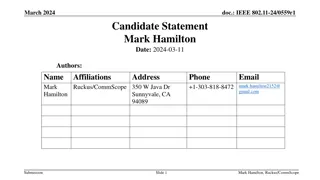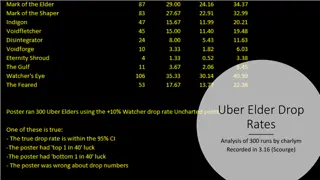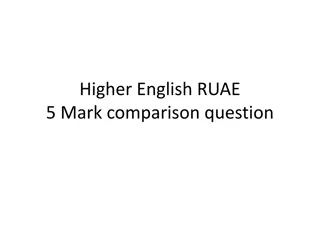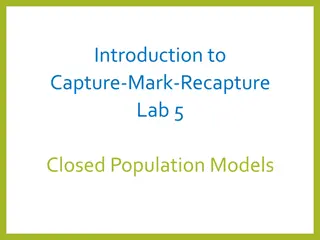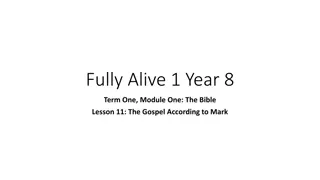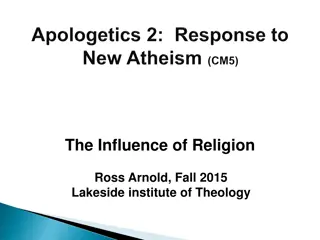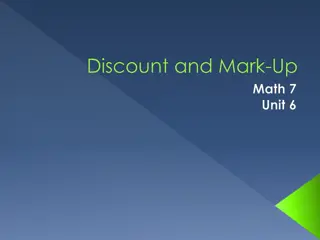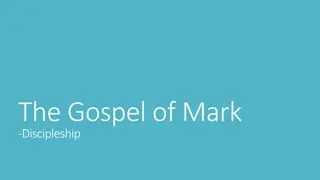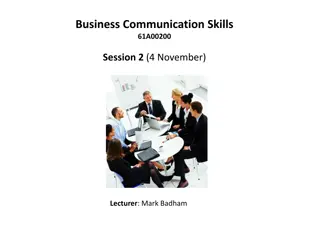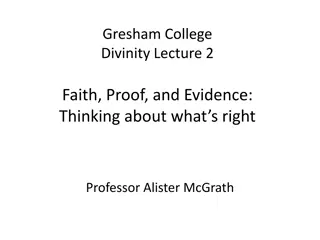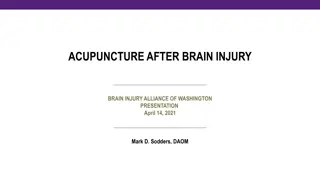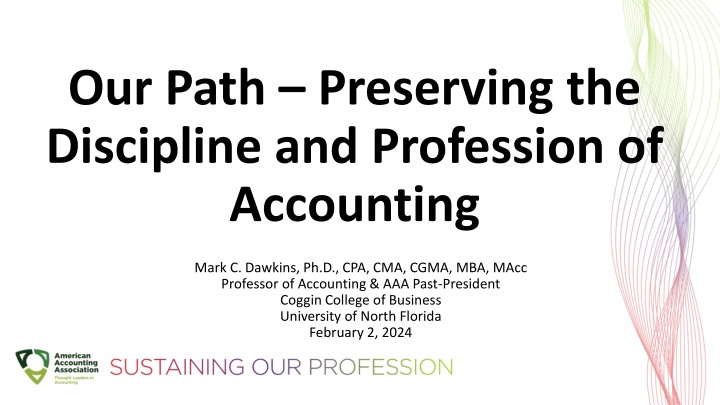
University Enrollment Trends: Impact on Undergraduate Education
Explore the significant declines in undergraduate enrollment at universities from Spring 2020 to Spring 2022, as reported by the National Student Clearinghouse Research Center. Discover how the pandemic has affected total student numbers and the comparisons between various enrollment periods, highlighting the challenges faced by higher education institutions.
Uploaded on | 1 Views
Download Presentation

Please find below an Image/Link to download the presentation.
The content on the website is provided AS IS for your information and personal use only. It may not be sold, licensed, or shared on other websites without obtaining consent from the author. If you encounter any issues during the download, it is possible that the publisher has removed the file from their server.
You are allowed to download the files provided on this website for personal or commercial use, subject to the condition that they are used lawfully. All files are the property of their respective owners.
The content on the website is provided AS IS for your information and personal use only. It may not be sold, licensed, or shared on other websites without obtaining consent from the author.
E N D
Presentation Transcript
Our Path Preserving the Discipline and Profession of Accounting Mark C. Dawkins, Ph.D., CPA, CMA, CGMA, MBA, MAcc Professor of Accounting & AAA Past-President Coggin College of Business University of North Florida February 2, 2024
University Enrollment Trends - Spring Per a 5/26/22 report on Spring 2022 enrollments issued by the National Student Clearinghouse Research Center (NSCRC): - Undergraduate enrollment declined 4.7% from spring 2021- spring 2022, after a decline of 4.9% from spring 2020-spring 2021. Thus, enrollment of undergraduate students fell 9.4% in two years, or nearly 1.4M students since the pandemic started (i.e., spring 2020-spring 2022), and 2.6M students over the past decade. 2
University Enrollment Trends Undergraduate enrollment fell more steeply in spring 2022 than it did in fall 2021 (-4.7% vs. -3.1%). The NSCRC s Fall 2021 enrollment report issued on 1/13/22 showed that enrollment of undergraduate students fell 6.6% in two years, or more than 1M students (i.e., fall 2019-fall 2021). As previously noted, the NSCRC s Spring 2022 enrollment report showed that enrollment of undergraduate students fell 9.4% in two years, or nearly 1.4M students since the pandemic started (i.e., spring 2020-spring 2022). Enrollment declines increased through most of the pandemic, until Fall 2023! 3
University Enrollment Trends Comparison Period Program Level SPRING % FALL % SP22 SP21 % Undergraduate (All) -4.7% SP21 SP20 % -4.9% FA21 FA20 % -3.1% FA20 FA19 % -3.6% Total 2-Year % -9.4% -6.6% Total 2-Year -1.4M -1M 4
University Enrollment Trends Per a 10/26/21 article in UniversityBusiness.com: - The fall 2021 two-year undergraduate enrollment decline of 6.6% was the largest in 50 years until spring 2022. - This 6.6% decline was exceeded by the spring 2022 two- year undergraduate enrollment decline of 9.4%. - The previous worst two-year period was a 3.3% decline from 2011-2013 when colleges and universities had just experienced all-time enrollment highs from the Great Recession. 5
University Enrollment Trends Per a 2/2/23 NSCRC report: - The undergraduate enrollment decline continued in fall 2022 with a 0.6 percent decline from fall 2021 (or 94,000 students), and total higher education enrollment was 5.8% below 2019 levels (or 1.1 million students). Per a 3/9/23 article in Fortune, total undergraduate enrollment declined about 8 percent from fall 2019 to fall 2022. This slide in the college-going rate is the steepest on record per the U.S. Bureau of Labor Statistics. 6
University Enrollment Trends The NSCRC s Fall 2023 enrollment report issued on 1/23/24 showed that enrollment of undergraduate students rose 1.2% from fall 2022-fall 2023, or 175,828 students. This 175,828-enrollee increase is the first increase since fall 2019. Only 10% of this increase was new freshmen (about 18,000 students). Most of the increase was due to continuing students and students returning from stop-outs! 7
University Enrollment Trends Per the 5/22/21 Hechinger Report: enrollment managers and observers expect the shock of plummeting numbers to trigger a renewed focus on affordability, retention, transfer and finding new markets in retraining older adults. 8
University Enrollment Trends Per a 5/22/21 Hechinger Report article and CDC data: - Federal data shows that the number of births in 2020 declined by 4 percent or 142,000, to the lowest point since 1979. - The number of births for the US in 2021 was 3.66M, up 1% from 2020 and the first increase in the number of births since 2014. The number of births for the US in 2022 was 3.67M. - Thus, fewer students will be entering colleges and universities 18 years from now. 9
University Enrollment Trends High school graduate projections released by the Western Interstate Commission for Higher Education (WICHE) on 12/15/20: The number of high school graduates is on track to peak across the country at 3.93 million with the Class of 2025. That s about 4% above the 3.77 million high school graduates in the Class of 2019. 10
University Enrollment Trends But within five years, the factors pushing toward larger graduating class sizes are not expected to be sufficient to counteract the effects of declining birth rates during the Great Recession. After 2025, the WICHE projections show graduating classes declining moderately in size over a dozen years attributable largely to the birth declines from families having fewer children during the Great Recession. 11
University Enrollment Trends In 2037, the U.S. high school graduating class is projected to total 3.52 million students - roughly the same size as it was in 2014. Only two states, Florida and Texas, are expected to have larger high school graduating classes in 2037 than they did in 2019. (I am glad I work in Florida!) 12
University Enrollment Trends Also, high school graduating classes are expected to diversity significantly in the coming years, led by growing proportions of Hispanic, multiracial, and Asian/Pacific Islander students. The first public high school graduating class that is no longer White non-Hispanic majority came in the Class of 2020 per a February 2023 report from WICHE. 13
University Enrollment Trends Change in HS Graduates Student Race/Ethnicity 2019 % of HS Graduates 2036 % of HS Graduates % Change Hispanic 25 28 +3 73,000 Multiracial 3 6 +3 Asian/Pacific Islander 6 8 +2 50,500 Black 14 14 - White 51 43 -8 -330,000 14
University Enrollment Trends To summarize the university enrollment trends data, high school graduating class size will peak in 2025 and return to approximate 2014 levels by 2037. High school graduating classes are expected to diversify significantly in the coming years due to growing proportions of Hispanic, multiracial, and Asian/Pacific Islander students. Next, Accounting Enrollment Trends 15
Accounting Enrollment Trends In the Illinois CPA Society s 2021 A CPA Pipeline Report Decoding the Decline, President & CEO Todd Shapiro states: we are witnessing a nationwide decline in not just new CPAs but also accounting program enrollments. Has enrollment decreased at your school? If so, your school is not alone. Enrollments are down 20-25% at some R1 schools and 30-50% at some private schools. 16
Accounting Enrollment Trends The 2023 AICPA Trends reportprovides statistical projections and respondent expectations based upon university responses for the 2021-2022 academic year and firm responses for the 2022 calendar year. Bachelor s degree completions in accounting dropped 7.8% in 2021-22 after steady declines of 1-3% per year since 2015-16. Master s degree completions fell 6.4% in 2021-22, and this decline is significantly less than in 2019-20. The number of new CPA exam candidates hit a 10-year low in 2020-21. 17
Accounting Enrollment Trends Even though overall accounting student graduates decreased in 2022 relative to 2020, racial/ethnic diversity increased in the 2021-22 academic year with universities reporting 1% increases in Hispanic or Latino accounting graduates at the bachelor s and master s levels, respectively. Thus, recruiting and graduating more diverse students will be increasingly important going forward, particularly the next 15 years. 18
Accounting Enrollment Trends Unfortunately, per the 2023 AICPA Trends report: Enrollment expectations continue to be optimistic, with 75% of responding bachelor s programs and 78% of responding master s programs expecting enrollment in 2023 24 to be the same or higher as in 2021 22. (page 5) But recruiting students is not the only issue . 19
Accounting Enrollment Trends In a September 2019 article in The CPA Journal, Dr. Alex Gabbin states: At the ground level, something has gone wrong with student perceptions about the value of an accounting education. Enrollment in James Madison University s (JMU) School of Accounting over the past four years, for example, has dropped 34% in the intermediate accounting courses...This is a stunning decrease for JMU saccounting program. 20
Accounting Enrollment Trends Dr. Gabbin believes JMU s experience over the past several years is not an anomaly to be dismissed; instead, it is an early warning that something significant has changed, perhaps long- term. I am aware of significant accounting enrollment declines at several R1 universities, and my co-authors and I published an article in the September 2020 issue of The CPA Journal that discusses declining MACC enrollments and implications for accounting graduate programs. 21
Accounting Enrollment Trends Michael Dugan and I have a follow-up article in the September/October 2022 issue of The CPA Journal entitled An Update on the Future of Accounting Education: A Pessimistic Outlook Calls for Major Changes that discusses declining undergraduate enrollments and implications for accounting programs. I wrote a commentary with recommendations in the February 2023 Issues in Accounting Education entitled Declining Enrollments A Call to Action! that is partly the basis for this presentation. 22
Accounting Enrollment Trends In his article, Dr. Gabbin asks the following 4 relevant questions (my responses in red): 1. Is the profession properly acknowledging differences in the generation of students now entering college? I believe the profession is increasingly aware of differences in new college students relative to past students (e.g., use of technology, affinity for social media, etc.). 23
Accounting Enrollment Trends 2. Are other professions becoming more attractive to top-tier students? Yes, particularly data analytics, supply chain, logistics, finance, and MIS or computer science. Each requires a 4-year degree leading to a job paying $15k-$30k more than a 5-year accounting degree. Accounting salaries need to significantly increase for accounting degrees to compete with these high-demand business degrees. 24
Accounting Enrollment Trends 3. Are there structural barriers to getting the CPA that have become onerous? Yes, a 9/22/21 Accounting Today survey of practitioners yielded the following suggestions: - drop the 150-hour requirement - extend the 18-month testing window (perhaps to 3-4 years) - increase salaries - reduce work hours - allow CPA exam candidates to qualify for the exam by reading or apprenticing under another CPA 25
Accounting Enrollment Trends 4. Finally, is the compensation package offered in public accounting sufficiently attractive to compensate for the increased demands being placed on new hires? No, as the prior two slides note, salaries need to significantly increase for accounting degrees to compete with data analytics, supply chain, logistics, finance, and MIS or computer science degrees. Accounting firms started increasing salaries over the past 2 years. Next, Accounting Student Hiring Trends 26
Accounting Student Graduate Trends Per the 2023 AICPA Trends report: Year Bachelor s % Change Master s % Change 2016-17 55,963 22,949 2017-18 55,377 -1.0% 23,141 0.8% 2018-19 53,991 -2.5% 22,323 -3.5% 2019-20 52,481 -2.8% 20,442 -8.4% 2020-21 51,031 -2.8% 19,484 -4.7% 2021-22 47,067 -7.8% 18,328 -6.4% 27
Accounting Student Hiring Trends In 2020, hiring of new accounting graduates decreased 10%, which followed an 11% decline from 2016-2018. New non-accounting graduates hired into accounting and finance functions have increased by 10%. As a percentage of all new graduate hires, non-accounting graduates were up 11.7% from 2018 to 2020, representing 42.7% of all hires by accounting firms in 2020 (up from 31.0% in 2018). (emphasis added) This trend is a significant challenge to accounting programs! 28
Accounting Student Hiring Trends Thus, the gap in skills required in the profession, especially as it relates to data analysis and technology needs, is being met with non-accounting graduates. Again, non-accounting hires represented 42.7% of all hires by accounting firms in 2020, an increase of 11.7% from 2018. What exactly is meant by the skills gap? 29
Accounting Student Hiring Trends A 3/12/21 Journal of Accountancy article titled Wanted: More systems and analytics training for accounting students, reports the following from an AICPA-NASBA gap analysis survey: Accounting departments should update their curricula to meet the demands of practice since there are "significant gaps between what practice is demanding and what students are learning in accounting programs . 30
Accounting Student Hiring Trends The survey asked whether accounting departments taught: Data analytics (64% said yes) IT audit (63%) IT risks and controls (43%) IT governance (41%) Predictive analytics (40%) Cybersecurity (40%) Digital acumen (23%) Systems and Organization Control (SOC) engagements (23%) 31
Accounting Student Hiring Trends Carl Mayes, CPA, the AICPA s associate director CPA Quality and Evolution, stated: The findings dovetail with what the CPA Evolution team has learned that employers need from accounting graduates The firms are demanding skills in data analytics and cybersecurity and IT audit and these other areas. Many graduates coming out of accounting programs don't have those skills, so they have to look elsewhere for that talent. 32
Accounting Student Hiring Trends Does your accounting department teach the following topics? Data analytics (64% said yes) IT audit (63%) IT risks and controls (43%) IT governance (41%) Predictive analytics (40%) Cybersecurity (40%) Digital acumen (23%) Systems and Organization Control (SOC) engagements (23%) 33
Accounting Student Hiring Trends Carl Mayes, CPA, the AICPA s associate director CPA Quality and Evolution, further stated: The takeaway for department heads is not that they need to have a separate course on each of the eight topics covered in the gap analysis only that they should assess their curricula and see which topics they might need to cover more thoroughly. 34
Accounting Student Hiring Trends Has your accounting department assessed its curricula? What changes or updates have been made or are in progress? What is the timeline for completion of changes or updates? Do you have the faculty needed to teach the changes or updates? If not, are you hiring or planning to hire? Next, CPA Exam Trends 35
CPA Exam Trends Per the 2023 AICPA Trends report, the number of CPA exam candidates decreased 17% between 2019-20, increased 6% between 2020-21, and decreased 6% between 2021-22. 2020-2022 saw the lowest number of new CPA candidates over the past 16 years (i.e., 2006-2022). The number of CPA Exam candidates who passed their fourth section of the exam decreased 11% between 2019 and 2020, and decreased another 9% between 2020 and 2022. 36
CPA Exam Trends The number of successful CPA exam candidates decreased 5.5% between 2020 and 2021, and decreased another 3.6% between 2021 and 2022. The 2019 AICPA Trends report states: We believe that for CPAs to continue to serve the marketplace, they must incorporate new and different skill sets and that it is incumbent upon the profession to take steps to cultivate these rapidly changing skills in accounting graduates and newly licensed CPAs. 37
CPA Exam Trends In the Illinois CPA Society s 2021 A CPA Pipeline Report Decoding the Decline, President & CEO Todd Shapiro states: A stagnating CPA pipeline is a threat. It s an issue that will only get worse and grow more troubling without action. He issued this warning in the 2016 Insight Special Feature, Pipeline Disruption: The Search for Solutions to the Weakening Supply of CPAs, and notes that five years later the issue has grown worse and more troubling. 38
CPA Exam Trends Mr. Shapiro further states: Compounding the CPA pipeline s troubling outlook is the waning presence of CPAs at the most visible and influential level of corporate finance the CFO. In Why You Don t Need to Be an Accountant to Be a CFO, the Wall Street Journal s Mark Maurer highlights that just 36 percent of CFOs at the 1,000 largest U.S. public companies were CPAs in 2019, which is the lowest figure in the six years Korn Ferry has collected the data Clearly, corporate America does not think of CPAs as strategic. 39
CPA Exam Trends Mr. Shapiro further states: We steadfastly believe the CPA credential and the CPA profession are in a race for relevance, and the time to act is now. (emphasis added) 40
CPA Exam Trends To act, the Illinois CPA Society developed a survey targeted toward accounting students, graduates, and professionals under the age of 35 (CPAs and non-CPAs) to gain insight into: 1) what is driving the decline in individuals pursuing the CPA credential, and 2) understanding why so many accounting students and young professionals either never take the CPA exam or do not finish the CPA exam. 41
CPA Exam Trends Responses from individuals who do not plan to become CPAs: 1. Not seeing value or relevance to their careers (32 percent), 2. Not seeing the return on investment (28 percent), 3. Their employers or prospective employers do not require or support it (28 percent), and 4. Other credentials or specialties are more valuable to their careers (28 percent). 42
CPA Exam Trends Responses from individuals in the process or planning to become CPAs, and individuals unsure about getting the CPA: 1. Time commitment needed to study for and pass the CPA exam. - workload time commitment (63 percent) - personal time commitment (41 percent) 2. Fear of failure (51 percent - students) 3. Difficulty of the CPA exam content (54 percent - students) 43
CPA Exam Trends CPA exam barrier misconceptions from this survey that were not validated or were unsubstantiated: 1.Costs associated either with obtaining the additional credit hours to meet the educational/licensing requirements * 2. Costs preparing for and taking the CPA exam * 3. Credential saturation and the pursuit of trending credentials are driving the decline of new CPAs * Ranked lower than anticipated on survey. 44
CPA Exam Trends When questioned about the CPA brand or how they viewed CPA , the words most associated with the CPA credential by all survey respondents were: accounting, auditing, and tax preparation. This indicates respondents have a narrow view of what CPAs do and a limited perception of the value CPAs bring to clients and companies as trusted and strategic business advisors. 45
Conclusions The race for accounting degree relevance is faster and more competitive than ever. Less than half of all accounting graduates ever sit for the CPA exam and even fewer eventually pass it. This is a major challenge for accounting programs and the profession! Accounting programs and firms must actively recruit increasingly diverse high school students while also recruiting from a declining White student population. 46
Conclusions Accounting programs must modernize/update its curricula to incorporate needed skills that are driving accounting firms to hire over 40% non-accountants. Accounting programs must ensure they have the faculty needed to successfully teach a modernized/updated curricula. Perceptions of the CPA must change from accounting, auditing, and tax preparation to strategic business advisors and/or as a potential path to entrepreneurship to appeal to high school and college students. 47
Conclusions The AICPA, NASBA, state societies, and accounting firms must stop shooting ourselves in the foot by considering: - Dropping the 150-hour requirement - Extending the 18-month testing window (perhaps to 4 years) - Increasing salaries to compete with data analytics, supply chain, logistics, finance, and MIS or computer science - Providing work/life balance by reducing work hours - Allowing CPA exam candidates to qualify for the exam by reading or apprenticing under another CPA. 48
The AAA looks forward to seeing everyone at the 2024 Annual Meeting in Washington, DC!

